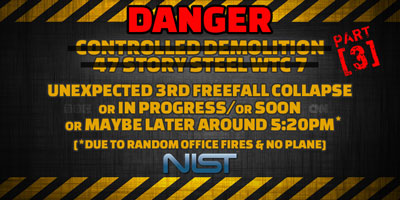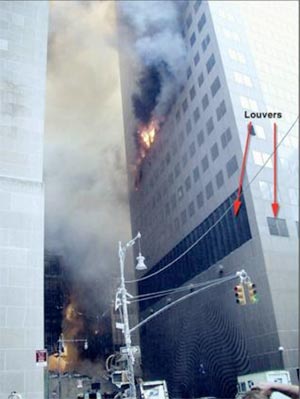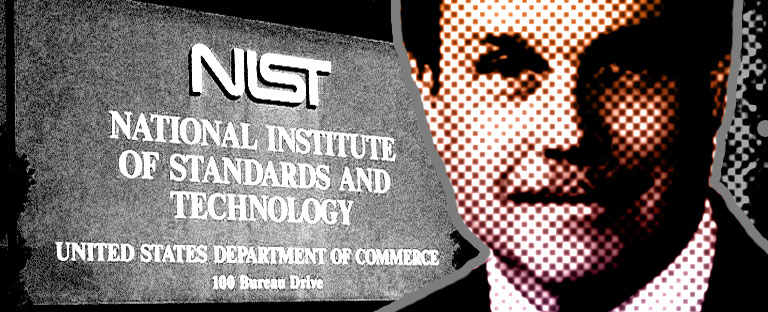Editor's Note: This fascinating and provocative technical piece on NIST’s manipulation of the WTC 7 evidence is broken down into a series of six articles. The third installment, below, is PART 2: NIST's Fictitious Gouge Launches Design Flaw Myth and Collapse Initiation Theory. The first installment was the INTRODUCTION. The second installment was PART 1: NIST and Popular Mechanics Fabricate Myth About WTC 7's "Scooped-Out" 10 Stories. Stand by for the next three installments, to be published monthly.
PART 2: Fictitious Gouge Launches Design Flaw Myth and Collapse Initiation Fantasy
By Simon Falkner and Chris Sarns
B Figure 4. We will be showing this "Plan View of Collapse Progression" in three installments of this series of articles. This is the second time, and we have labeled it "B." Note columns 76 to 81 and column 78A in the orange section. Also note the adjacent truss #1, truss #2, and the east transfer girder.
Figure 4. We will be showing this "Plan View of Collapse Progression" in three installments of this series of articles. This is the second time, and we have labeled it "B." Note columns 76 to 81 and column 78A in the orange section. Also note the adjacent truss #1, truss #2, and the east transfer girder.
NIST's report in early 2004 suggested that the east penthouse caved in primarily due to fire damage to column 79. It also suggested that the possible failure of the other structural components listed above could have made the critical column 79 more susceptible to fire damage. Also note that the mythical 10-story gouge "scooped out" column 78A, giving NIST the only "evidence" it had for the failure of one of those "other structural components." Finally, note that the debris that allegedly created the gouge would have provided NIST with the only remotely plausible explanation for the cause of the mythical diesel fire on the fifth floor.
 Considering the lack of evidence, as we outlined in Part 1, NIST's early insistence on the 10-story gouge, as dramatized in the 2005 Popular Mechanics magazine article, makes no sense, until you realize that the agency was reverse engineering its theory for the demise of Building 7. In other words, because NIST's 2004 preliminary report contended that the east penthouse could cave in (as the videos show) if column 79 were to buckle, it had to make up a story to account for the failure of that column in order to sell its theory to the scientific community and to the public.
Considering the lack of evidence, as we outlined in Part 1, NIST's early insistence on the 10-story gouge, as dramatized in the 2005 Popular Mechanics magazine article, makes no sense, until you realize that the agency was reverse engineering its theory for the demise of Building 7. In other words, because NIST's 2004 preliminary report contended that the east penthouse could cave in (as the videos show) if column 79 were to buckle, it had to make up a story to account for the failure of that column in order to sell its theory to the scientific community and to the public.
The trouble is, NIST had no legitimate reason to cite a failed column, since it had absolutely no evidence showing that any column under the east penthouse had been subjected to massive fires. What it did have, however, was what is referred to in polite company as "creative thinking."
"The gouge" could have ruptured a diesel fuel line
NIST had received no reports of fires on the fifth floor at any time, but in PM's 2005 article Sunder made a big deal of a supposed diesel-fueled fire on the fifth floor — a fire that, he claimed, may have lasted up to seven hours. The only excuse NIST had to cite a diesel fire was the fact that a room in the northeast corner of the fifth floor contained four diesel generators that were fed by a pressurized fuel line from two large tanks under the loading dock on the ground level. So, since there was fuel present, the agency reasoned that there could have been a fire there as well. But as we shall see in PART 3, NIST later admitted that this fire did not exist.

Figure 5. This photo from the 2002 FEMA report shows WTC 7's northeast corner generator room louvers. Taken at about 2:10 PM on September 11, 2001, the photo proves that there was no fire in this part of the building (the northeast corner, floors five and six). If there had been, smoke would be pouring out through the louvers. Had the louvers been closed, some smoke would have escaped (see Figure 6), but any fire inside would not have had sufficient oxygen to burn hot enough to be a factor in the collapse of the building.
Some event would have been required to rupture the fuel line and ignite the fuel, but the agency was vague when it came to evidence for such an event. The report gave the impression that damage to the south face due to falling debris could somehow explain the fire, but it failed to cite a sequence of events that could lead to the fire. And as we shall see, even though NIST did not say so itself, it had no explanation for this fire that could look even remotely plausible — without concocting its mythical gouge, that is.
The only legitimate evidence for citing damage to the south face (see PART 1) were reports of damage to the southwest corner and reports of a large hole, around floor 14, near the center of the south face. Still, neither the corner damage nor the 14th-floor hole sufficed as a plausible explanation for damage to the fuel line feeding the generators in the northeast corner of the fifth floor. NIST must have surmised that a gouge from Floor 10 down to the ground in the middle of the south face would be a more plausible explanation, however, because any impact from the North Tower material responsible for that supposed gouge would have been a lot closer to the generator room and thus more likely to shake the generator room violently enough to rupture the fuel line. (The fuel line supposedly broke where it enters the junction box attached to the generator room ceiling.)
Debris supposedly caused critical fire
But even if the fuel line had been ruptured, what would have initiated the reported fifth-floor fire?
NIST implies that the fires in Building 7 were started by debris from the collapsing (and burning) North Tower. But debris fires at the southwest corner or at the hole around Floor 14 would not have been a satisfying explanation for a fire in the northeast corner on Floor 5.

Figure 6. This photo, called Figure 5-142 in NIST's final report, is a frame taken from a video that was shot near the corner of West Broadway and Barclay Street. It shows the louvers that span the 5th and 6th floors in the northeast corner of WTC 7, and was taken between 3:55 PM and 4:04 PM on 9/11/01. (For a photo taken approximately two hours earlier, see Figure 5). The absence of black smoke — the color of smoke that always accompanies a diesel fuel fire — demonstrates that roughly 80 minutes before WTC 7 collapsed at 5:21 PM, there was no indication that a diesel fire had broken out in the building.
Sunder gave away NIST's thinking in the 2005 PM article when he claimed that this diesel fire lasted up to seven hours. It appears he made that observation to build his case that the North Tower debris, which supposedly created the gouge, must have somehow caused the diesel fire as it was creating that gouge, since Building 7 collapsed approximately seven hours after the North Tower collapsed. Though neither the 2004 NIST report nor the 2005 PM article ever said in so many words that WTC 1's debris caused WTC 7's diesel fire, NIST must surely have realized that the public would infer as much.
NIST's 2004 report also noted that the debris most likely caused damage to other structural components in the east penthouse area (see the orange section in Figure 4 above). The failure of these east penthouse components, NIST argued, would have transferred excessive stress to the critical column (#79) and made it more vulnerable to the claimed fire damage that supposedly buckled it in the end. Thus, in retrospect, it is easy to understand why NIST insisted on the 10-story gouge in the 2005 PM article: By referring to the gouge, NIST was supplying documented "evidence" that could account for the "falling of the first domino," in case anyone were to ask questions later.
Predictably, Popular Mechanics did not ask those questions, despite its alleged team of "professional fact checkers." But it is interesting to note that Sunder made sure that the magazine based the collapse explanation primarily on the 10-story gouge and that it cited fire damage only as a possible secondary contributing factor. PM's prioritizing of the 10-story gouge was a complete reversal of NIST's 2004 report, where fire was said to be the main factor in the building's collapse. This reversal shows how little confidence NIST really had in its 2004 report, even though the PM article was obviously set up to give the impression that NIST was on top of things.
Myth: Building 7 "Doomed to Fail"
The magazine authors did not seem to mind that NIST's theory had another fundamental flaw. Even if it accepted NIST's explanation for the collapse of the east penthouse, PM should have noticed that NIST did not address the main problem that it was tasked with solving: Why did the whole building fail catastrophically (neatly imploding in under seven seconds)?
PM's convenient absence of critical questions gave NIST the "out" it needed: It could circumvent the fatal flaws in its logic by allowing the magazine article to imply, on NIST's behalf, that Building 7's design was inherently unsound and weak — and thus "doomed to fail." As PM put it, "According to NIST, there was one primary reason for the building's failure: In an unusual design, the columns near the visible kinks were carrying exceptionally large loads, roughly 2000 sq. ft. of floor area for each floor." [Emphasis added.]
PM was essentially pinning the blame on WTC 7's designers. But was it fair to imply that the architects and engineers of WTC 7 designed a building where the failure of only one column could trigger the implosion of the entire building?
Hardly. Modern steel-framed buildings are engineered to assure that they don't fall down, and none have, except on 9/11/2001. As Larry Silverstein, the owner of the building, told The New York Times in a 1989 interview: ''We built in enough redundancy to allow entire portions of floors to be removed without affecting the building's structural integrity, on the assumption that someone might need double-height floors. . . .''
It is true that WTC 7 did have an unusual design: It was an irregular trapezoid and it was built over the ConEd electrical substation. But in its final report, NIST acknowledged that "[t]he transfer elements such as trusses, girders, and cantilever overhangs that were used to support the office building over the Con Edison substation did not play a significant role in the collapse of WTC 7." In fact, had Building 7 not provided a solid foundation, it would hardly have been chosen to house the mayor's emergency command center.
One could say that PM magazine was implicitly asking its readers to believe that, because of a flawed design, the collapse of only one column — out of 82 columns in total — brought down the whole building in the exact manner of a controlled demolition. In a pre-planned, pre-planted controlled demolition, carefully timed explosives are used to take out all the supporting columns. (We will review controlled demolitions in PART 5).
Granted, at the time, PM may not have known that NIST would refuse to share the input data for its computer analysis with the scientific community (on the completely spurious basis that it "might jeopardize public safety"), thus making independent verification of its conclusions impossible. Nonetheless, for the magazine authors to have accepted Sunder's narrative at face value was unprofessional and calls its motives into question.
In the next (fourth) installment of this series of six articles, PART 3: Popular Mechanics Helps NIST Create Myths About Trusses and Tanks, the authors explore how PM magazine helped NIST propagate two more false myths — one concerning certain trusses, the other about a non-existent diesel fuel tank fire.






